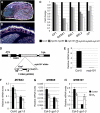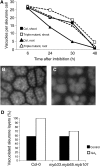The microRNA159-regulated GAMYB-like genes inhibit growth and promote programmed cell death in Arabidopsis
- PMID: 20699403
- PMCID: PMC2949021
- DOI: 10.1104/pp.110.160630
The microRNA159-regulated GAMYB-like genes inhibit growth and promote programmed cell death in Arabidopsis
Abstract
The microRNA159 (miR159) family represses the conserved GAMYB-like genes that encode R2R3 MYB domain transcription factors that have been implicated in gibberellin (GA) signaling in anthers and germinating seeds. In Arabidopsis (Arabidopsis thaliana), the two major miR159 family members, miR159a and miR159b, are functionally specific for two GAMYB-like genes, MYB33 and MYB65. These transcription factors have been shown to be involved in anther development, but there are differing reports about their role in the promotion of flowering and little is known about their function in seed germination. To understand the function of this pathway, we identified the genes and processes controlled by these GAMYB-like genes. First, we demonstrate that miR159 completely represses MYB33 and MYB65 in vegetative tissues. We show that GA does not release this repression and that these transcription factors are not required for flowering or growth. By contrast, in the absence of miR159, the deregulation of MYB33 and MYB65 in vegetative tissues up-regulates genes that are highly expressed in the aleurone and GA induced during seed germination. Confirming that these genes are GAMYB-like regulated, their expression was reduced in myb33.myb65.myb101 seeds. Aleurone vacuolation, a GA-mediated programmed cell death process required for germination, was impaired in these seeds. Finally, the deregulation of MYB33 and MYB65 in vegetative tissues inhibits growth by reducing cell proliferation. Therefore, we conclude that miR159 acts as a molecular switch, only permitting the expression of GAMYB-like genes in anthers and seeds. In seeds, these transcription factors participate in GA-induced pathways required for aleurone development and death.
Figures










References
Publication types
MeSH terms
Substances
LinkOut - more resources
Full Text Sources
Molecular Biology Databases

